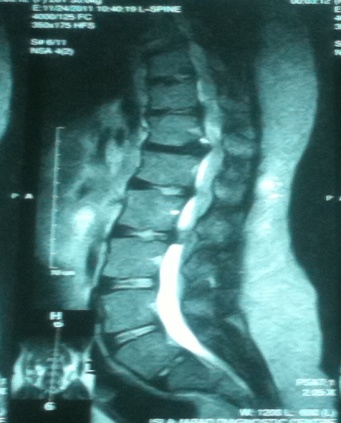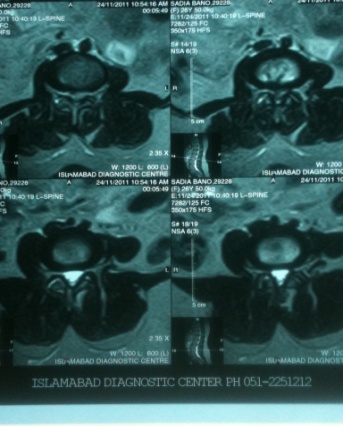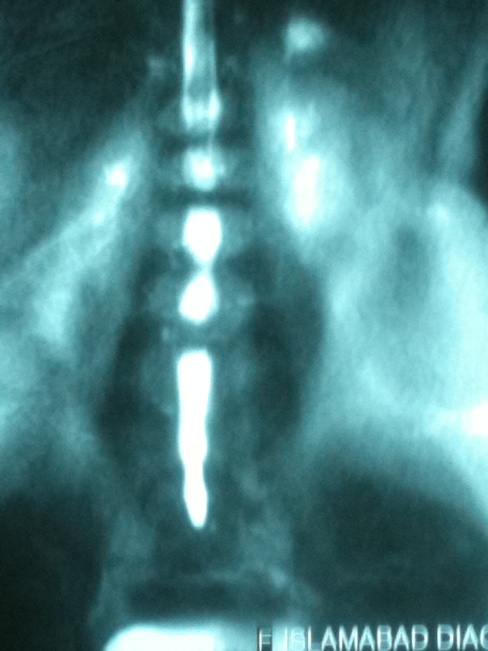Adil Aziz*, M.Waseem Khan**, Sameen Shoaib***
*Registrar, **Consultant Neurosurgeon, ***Medical Officer
Department of Neurosurgery, Fauji Foundation Hospital, Jhelum Road, Rawalpindi (Pakistan).
Correspondence: Dr.Adil Aziz Khan, House No. 25, PAF Base Road, Askari-VIII, Chaklala, Rawalpindi (Pakistan); Cell: 0305-5550335; E-mail: khanadil_1@hotmail.com
ABSTRACT
Achondroplasia is the most common non-lethal skeletal dysplasia. Its incidence is between 1 in 10,000 to 1 in 30,000; with half of the patients showing various neurological manifestations. We are presenting an interesting case of a 26 year old lady with short stature, who presented with acute pain in the front of the thigh for three months. Plain x-rays showed platyspondylosis with developmental anomalies of the posterior neural arch/dysplasia. MRI dorsolumbar spine showed congenital stenosis in this area. The stenosis was more pronounced at L2-3 .She was treated with L2-3 laminectomy and discectomy. On follow-up, she was symptom free with no residual neurological damage.
Keywords: Achondroplasia; Backache; Lumbar spinal stenosis
CITATION: Aziz A, Khan MW, Shoaib S. Achondroplasia and lumber spinal stenosis: A Case report and review of literature. Anaesth Pain & Intensive Care 2012;16(1):64-66
INTRODUCTION
Achondroplasia is the most common non-lethal skeletal dysplasia.1 It is the most common type of rhizomelic dwarfism and is caused by a mutation of fibroblast growth factor receptor-3.2, 3 The primary defect found in patients with achondroplasia is abnormal endochondral ossification.4 Half of the patients show various neurological complications. The most serious complication of achondroplasia is respiratory impairment, apnea and sudden infant death, resulting from compression of the medulla oblongata.5 Spine surgery, requires evaluation of both spinal stenosis and instability. These patients are best evaluated by a multidisciplinary team.6 Fusion procedures are recommended in patients with a large decompression, overlying a thoracolumbar kyphosis to avoid progressive postoperative deformity.4 The tendency toward paralysis and paraplegia is much higher in this set of patients. Special attention must be given to technical details when operating on achondroplastic dwarfs. Early and most extensive surgery is recommended.7
CASE REPORT
A 26 year old lady who was bed ridden, presented with acute pain in front of the thigh bilaterally for three months. The pain in front of the thigh was so severe that the patient was unable to sleep at night. There was no history of backache or trauma.
Patient was initially seen by the medical department and Doppler USG of the lower limb was advised to rule out a vascular pathology. On examination power was reduced at the hip flexors to 4/5. Rest of the examination was unremarkable. Clinical vascular examination of the lower limb was also normal. No past medical and surgical history of significance was present.
All routine investigations were within normal limits. A plain x-ray showed platyspondylosis with developmental anomalies of the posterior neural arch/dysplasia. MRI of the dorsolumbar spine showed congenital stenosis from L1 to L5, more pronounced at L2-3 (Fig: I, II and III). L2-3 laminectomy and discectomy was done. The patient became symptom free just after surgery and returned to his routine work.
Fig I: MRI dorsolumbar spine T2 weighted image sagital view
Fig II: MRI Dorsolumbar spine T2 weighted image axial view
Fig III: MRI dorsolumbar spine myelogram
DISCUSSION
The skeletal dysplasias are a heterogeneous group of disorders characterized by intrinsic abnormalities in the growth and/or remodeling of cartilage and bone. These dysplasias affect the skull, spine, and extremities in varying degrees.8 The abnormal spinal development of the achondroplastic dwarf can result in neurologic damage due primarily to the following two syndromes: lumbar spinal canal stenosis and thoracolumbar kyphosis.3
In the general category of congenital spinal stenosis, there is a group of patients with particular features; patients suffering from a hereditary or systemic disease with congenital narrowing of the spinal canal. Evaluation of their neurological symptoms is influenced by the peculiarities of the underlying disease.7 They frequently cause a disproportionately short stature, the standing height falls below the third percentile for age.
Fibroblast growth factors are structurally related proteins associated with cell growth, migration, wound healing, and angiogenesis. At the cellular level, their function is mediated by transmembrane tyrosine kinase receptors, known as fibroblast growth factor receptors (FGFR). Mutation in FGFR3 is responsible for achondroplasia, hypochondroplasia, and thanatophoric dysplasia.The primary function of FGFR3 is to limit osteogenesis. Mutation causes enhancement in its function of limiting endochondral ossification. Mutation in FGFR3 in achondroplasia is due to transition of guanine to adenine (G to A) at nucleotide 1138 of complimentary DNA.9
Wide, multilevel laminectomies extending to the pedicles and lateral recesses with foraminotomies may be necessary. Extradural removal of herniated disc material is performed as necessary.10 The length of decompression usually extends from the lower thoracic spine to the sacrum to prevent recurrence. Maintaining the integrity of facet joints is necessary to prevent postlaminectomy instability. If instability does occur, anterior fusion may be necessary.
REFERENCES
1. Baujat G, Legeai-Mallet L, Finidori G, Cormier-Daire V, Le Merrer M. Achondroplasia. Best Pract Res Clin Rheumatol 2008; 22(1): 3-18.
2. Shirley ED, Ain MC. Achondroplasia: manifestations and treatment. J Am Acad Orthop Surg 2009; 17(4): 231-41.
3. Savini R, Gargiulo G, Cervellati S, Di Silvestre M. Achondroplasia and lumbar spinal stenosis. Ital J Orthop Traumatol, 1991; 17(2): 199-209.
4. Sciubba DM, Noggle JC, Marupudi NI, Bagley CA, Bookland MJ, Carson BS Sr, Ain MC, Jallo GI. Spinal stenosis surgery in pediatric patients with achondroplasia. J Neurosurg. 2007; 106: 372-8.
5. Gil Z, Tauman R, Sivan J, Orr-Urtreger A, Constantini S. Neurosurgical aspects in achondroplasia: evaluation and treatment.Harefuah. 2001 Nov; 140(11): 1026-31.
6. King JA, Vachhrajani S, Drake JM, Rutka JT. Neurosurgical implications of achondroplasia. J Neurosurg Pediatr. 2009 Oct; 4(4): 297-306.
7. Rubeli M, Grob D. Lumbar spinal stenosis in systemic diseases and in hereditary syndromes. Orthopade. 1993 Aug; 22(4): 250-6.
8. Smoker WR, Khanna G. Imaging the craniocervical junction.Childs Nerv Syst. Oct 2008; 24(10): 1123-45.
9. Wang Q, Green RP, Zhao G, Ornitz DM. Differential regulation of endochondral bone growth and joint development by FGFR1 and FGFR3 tyrosine kinase domains. Development. Oct 2001; 128(19): 3867-76.
10. Pyeritz RE, Sack GH Jr, Udvarhelyi GB. Thoracolumbosacral laminectomy in achondroplasia: long term results in 22 patients Am J Med Genet. 1987; 28(2): 433-44.




